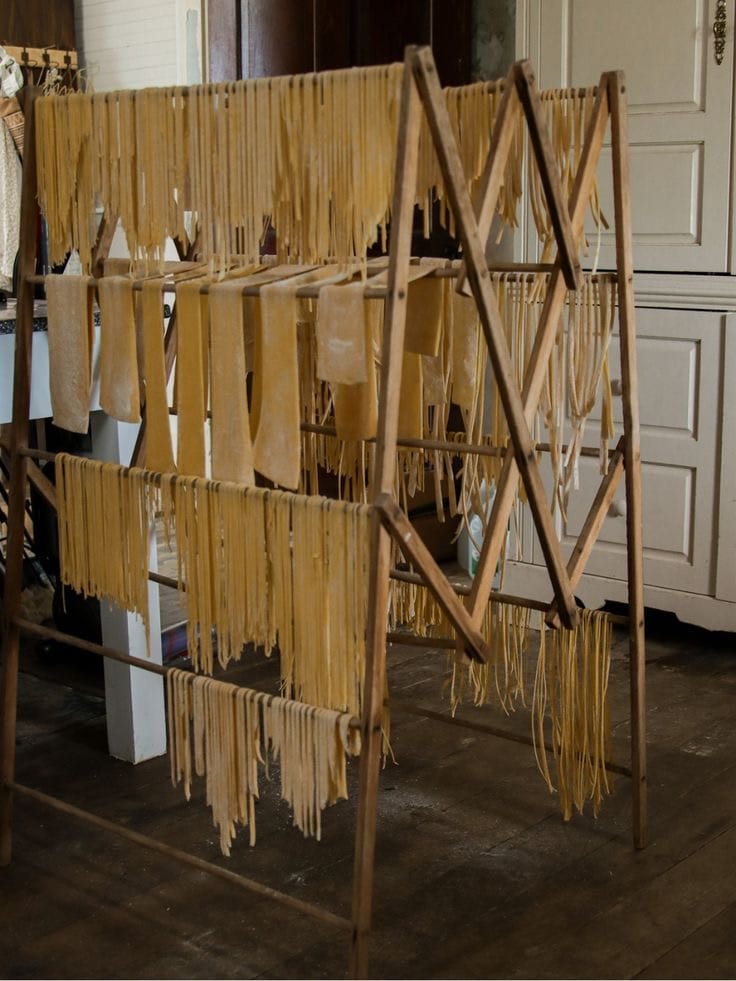
Make your own pasta. We really don't have much to say other than this. It's simple and only takes a couple of ingredients but gives us so much in the process. Making our own foods has always been and will always be superior to anything store bought. And things like pasta and sourdough are the easiest places to start. It's pretty hard to fuck up a carb.
The Ingredients, Fewer Than You Think
Fresh pasta only needs two things: flour and eggs. The rest is optional.
- Flour: Traditionally, Italian 00 flour is used for its fine texture (even the first time we made pasta, we used this and it was perfect), but all-purpose works if that’s what you have.
- Eggs: Room temperature, always. Freshness and free range matters (obviously), it affects both colour, flavour and ethics.
- Salt: Just a pinch in the dough for flavour.
- Olive oil: Optional, but a drizzle can make the dough silkier.
The Ratio: 100g flour to 1 large egg is the classic formula, and enough for one generous serving.
The Method
1. Create the well
On a clean counter, large board or stainless steel bowl, pour your flour into a mound and make a well in the centre, wide enough to hold the eggs.
2. Whisk in place
Crack the eggs into the well and use a fork to beat them lightly, gradually pulling in flour from the edges.
3. Bring it together
Once the mixture is too thick to whisk, use your hands to fold it into a rough dough. It will feel shaggy and imperfect at first, keep going, it will fix itself.
4. Knead
Push the dough away from you with the heel of your hand, then fold it back. Repeat for 8 -10 minutes until smooth and elastic. If it’s sticky, dust lightly with flour; if it’s dry, wet your hands and continue.
5. Rest.
Wrap the dough in cling film or cover with a bowl and let it rest for at least 30 minutes. This allows the gluten to relax and makes rolling easier.
Rolling & Shaping
If you have a pasta machine, run the dough through the widest setting, folding and re-rolling until smooth, then gradually reduce the thickness. If you’re working with a rolling pin, patience, even pressure and a relaxation on being perfect are key.
Once rolled, dust lightly with flour or semolina and cut into your chosen shape:
- Tagliatelle or fettuccine: Fold the sheet loosely and slice with a sharp knife.
- Pappardelle: Wide ribbons for rich, slow-cooked sauces.
- Ravioli or tortellini: Fill with ricotta and herbs, or anything you like.
Cooking & Serving, Minimal Is Always Best
Fresh pasta cooks quickly, in 2 minutes in salted boiling water. Reserve some of that pasta water; it’s liquid gold if you're making a sauce.
Pair it with sauces that don’t overpower:
- Butter, sage, and Parmesan
- Olive oil, garlic, and fresh chilli
- Cherry tomato, garlic and basil
- Creamy mushroom and wild garlic
Don't bury your pasta in heavy calories, keep it light but full of flavours.
Why We Will Always Make It Fresh
Making pasta isn’t just about what ends up on our plate. It’s about getting back to our roots, using our hands, and making something from scratch. There's nothing like the pride of eating something you made yourself. It’s an old-world pleasure that never really lost its charm, and the more you do it, the easier it gets, and the better you get.
Serve it to friends, roll it on a midweek evening, or make a habit of it every Sunday. In a world where so much is rushed, fresh pasta is a small rebellion against it.
